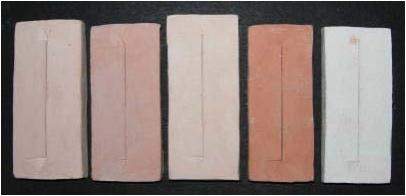Dry strength is the nature of the clay body of ceramic objects that have been dried, it is very important because the nature of ceramic objects to be strong enough to be lifted, refined, and arranged in a furnace. Clay that has a high plasticity will be higher the dry strength.
Ballclay is a material that has a good dry strength, but when made objects will arise cracked.
Dry strength is affected: grain fineness plasticity curing time (aging) the amount of water forming mixing with other materials forming techniques
Color Burn
Clay in the raw state obtained from the place of origin (deposits) have a variety of colors such as beige, tawny, brownish red, gray, and black, the color difference is influenced by the ratio of the levels of ingredients include a mixture of clay or dirt humus (organic ), iron oxide (Fe), etc..
After experiencing the process of burning clay color that sometimes appears different with colors in the raw state, it is influenced by substance / material contained therein is chemically bound. Organic impurities would be burned out at the time of the combustion process takes place, while the materials are chemically bonded to cause the clay to color.
Clay color is caused by substances that pollute, gray to black carbon and contain the remains of plants, containing red iron oxide (Fe) but can also be produced by adding dyes such as cobalt (Co), cupper (Cu ), chromium (Cr), iron (Fe), manganese (Mn). In general, the type most widely Earthenware clay containing oxides of iron (Fe). Fuel color (biscuit temperature of 900oC) pure clay Sukabumi, Pacitan, Malang, Bojonegoro, and Singkawang as shown in the figure below.
Power suspension is a trait that allows a mixture atausuatu material remains in liquid form, these properties are related to plasticity.
Flocculant: a substance that serves to accelerate the deposition of clay granules, namely: magnesium sulfate
Deflokulan: a power enhancing substance yandg dispersion (crystallize) so that the clay granules remained hovering, namely: waterglass / sodium silicate and sodium carbonate. Deflokulan clay used for the formation of cast molding technique.
Slaking properties
The nature of the clay to be crushed in water droplets that become more refined in a certain time and at normal air temperatures. When a clay (clay) put in water, the clay gets wet and then expands, then clay crumbled into small parts. The less power tie the faster dissolution of clay, soft and porous clay tends to disintegrate faster in water than hard clay. The slaking properties associated with the softening of the clay.
